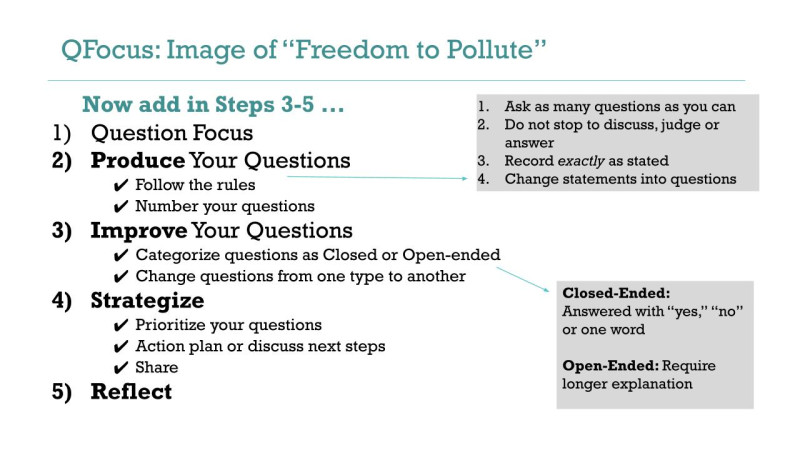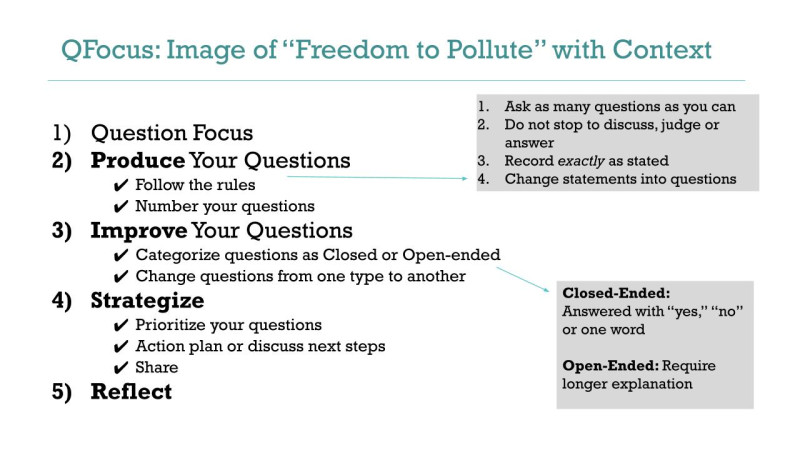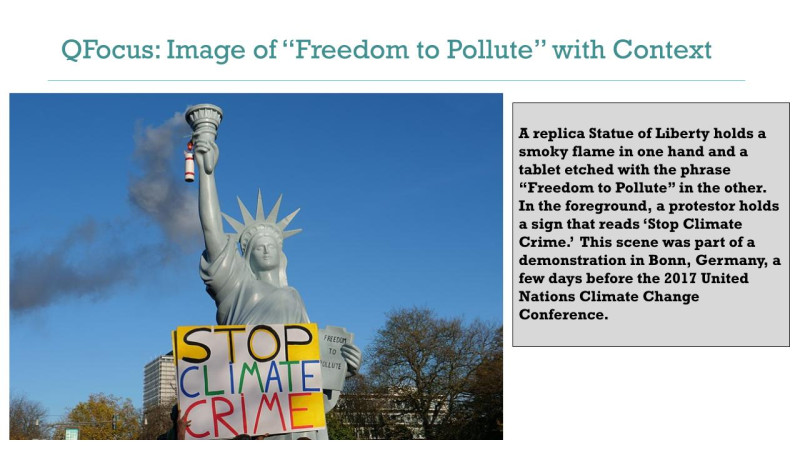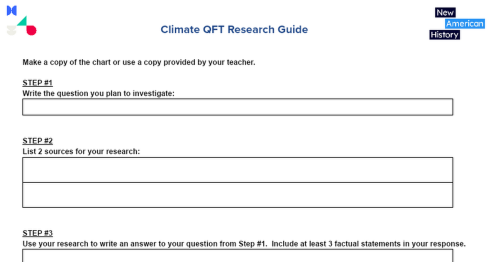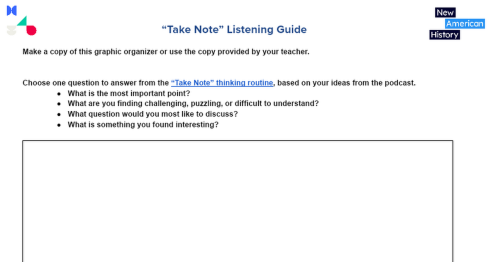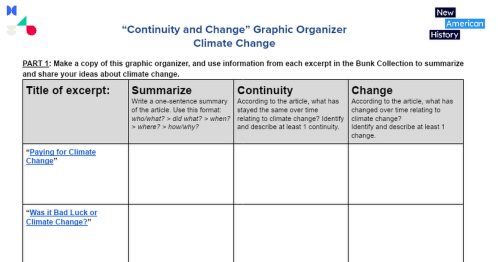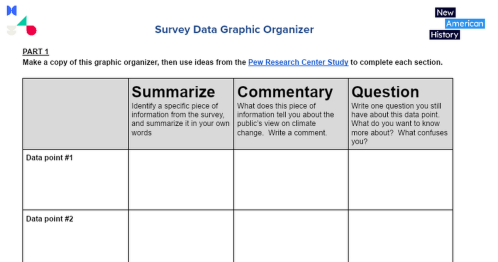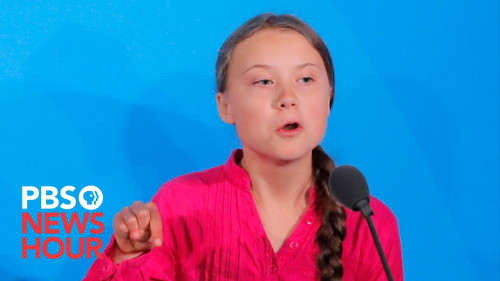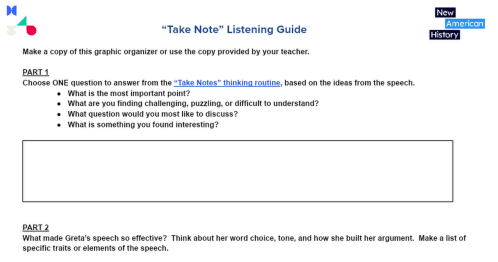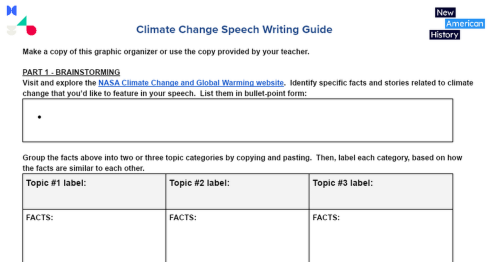This work by New American History is licensed under a Attribution-NonCommercial-ShareAlike 4.0 (CC BY-NC-SA 4.0) International License. Permissions beyond the scope of this license may be available at newamericanhistory.org.
How Can Americans Act to Curtail Climate Change?
View Student Version
Standards
C3 Framework:D2.His.3.6-8. D2.His.3.9-12.
National Council for Social Studies:Theme 2 - TIME, CONTINUITY, AND CHANGETheme 5 - INDIVIDUALS, GROUPS, AND INSTITUTIONS
College Board AP U.S. History (Fall 2020)HISTORICAL THINKING SKILLS COVERED:SKILL 4.A – Identify and describe a historical context for a specific historical process or development.SKILL 5.A: Identify patterns or connections between historical developments.
TOPIC 8.13THEME 3: GEOGRAPHY AND THE ENVIRONMENT (GEO) This theme focuses on the role of geography and both the natural and human-made environments in the social and political developments in what would become the United StatesUNIT 8 LEARNING OBJECTIVE O: Explain how and why policies related to the environment developed and changed from 1968 to 1980.KC-8.2.II.D: Environmental problems and accidents led to a growing environmental movement that aimed to use legislative and public efforts to combat pollution and protect natural resources. The federal government established new environmental programs and regulations.
TOPIC 9.6THEME 6: AMERICA IN THE WORLD (WOR) This theme focuses on the interactions between nations that affected North American history in the colonial period and on the influence of the United States on world affairsUnit 9: Learning Objective F. Explain the causes and effects of the domestic and international challenges the United States has faced in the 21st century.KC-9.3.II.C: Conflicts in the Middle East and concerns about climate change led to debates over U.S. dependence on fossil fuels and the impact of economic consumption on the environment.
National Geography Standards: Standard 4. The physical and human characteristics of places.Standard 6. How culture and experience influence people’s perceptions of places and regions.
Suggested Grade Levels: High School (9-12), especially Advanced Placement U.S. History course
Suggested Timeframe: Two 90-minute class periods
Suggested Materials: Internet access via laptop, tablet or mobile device, projection screen
Key Vocabulary
Climate change deniers - those who deny or dismiss the scientific consensus about climate change
Climate refugees - people forced to flee their homes because of natural disasters, droughts, or other extreme weather events
Consensus - a general agreement arrived at by most of those involved
Continuity - the consistent existence of something over a period of time
Generalization - a general statement or concept arrived at by linking specific cases together
Global warming - the long-term heating of Earth’s climate system, occurring because of human activities -- especially fossil fuel burning -- which increases heat-trapping greenhouse gas levels in Earth’s atmosphere
Industrialization - the widespread development of industries in a country, economy, and culture
Rubric - in education a rubric is a guide for scoring used to evaluate the quality of students' responses. It often serves as a set of criteria for grading assignments.
Read for Understanding
Teacher Tips:
This Learning Resource includes language in the body of the text to help adapt to a variety of educational settings, including remote learning environments, face-to-face instruction, and blended learning.
If you are teaching remotely, consider using videoconferencing to provide opportunities for students to work in partners or small groups. Digital tools such as Google Docs or Google Slides may also be used for collaboration. Rewordify helps make a complex text more accessible for those reading at a lower Lexile level while still providing a greater depth of knowledge.
In 2021, the United Nations published its most recent report on Climate Change, deeming it a global crisis. This update, including an interactive atlas and policy brief, provides an excellent opportunity for history educators to work alongside their civics/government and environmental science colleagues to create interdisciplinary units of study. We encourage you to share this report and these learning resources with your colleagues as you prepare your learning experiences for students.
This Learning Resource uses the Question Formulation Technique, a multi-step group activity from the Right Question Institute that allows students to strengthen their skills in creating their own questions. It will be helpful to read the QFT Outline before conducting the Engage activity.
In addition, this Learning Resource uses “Thinking Routines” from Project Zero, a research center at the Harvard Graduate School of Education that has developed learning strategies that encourage students to add complexity to their thought process. For an overview of Project Zero’s methodology, you may want to read its Exploring Complexity Bundle. Specifically for this lesson, students will use these thinking routines: See, Think, Wonder; I Used to Think...Now I Think; Take Note; Values, Identities, Actions; Headlines.
Also, this Learning Resource features Bunk Collections, which are groups of Bunk excerpts that share a common topic or theme. Here is more information on how Bunk Collections work.
Lastly, these Learning Resources follow a variation of the 5Es instructional model, and each section may be taught as a separate learning experience, or as part of a sequence of learning experiences. We provide each of our Learning Resources in multiple formats, including web-based and as an editable Google Doc for educators to teach and adapt selected learning experiences as they best suit the needs of your students and local curriculum. You may also wish to embed or remix them into a playlist for students working remotely or independently.
For Students:
In 2021, the United Nations published its most recent report on Climate Change, deeming it a global crisis. Across the globe, young people are leading the fight against global warming and modeling ways to help save the planet. These learning resources will help you explore Climate Change, including ways you might take action. For more information on how you might get involved, visit Fridays for Future or follow #FridaysforFuture on social media.
Engage:
Is America doing enough to address global climate change?
One of the most important challenges facing America -- and the world -- in the 21st Century is climate change, which, according to NASA, is defined as the long-term change in the average weather patterns of the Earth’s climates.
- How has America contributed to climate change over the last 200 years?
- More specifically, how has America’s dependence on fossil fuels and its increased economic consumption impacted the environment?
- How might America act to address climate change, both within the nation and as a partner in the world community?
Explore these questions using the visual discovery learning experience below:
VISUAL DISCOVERY: Analyze this image from a protest in Bonn, Germany, a few days before the 2017 United Nations Climate Change Conference. Use your copy of the “See, Think, Wonder” graphic organizer, adding at least 2 ideas for each category. Share your ideas in small groups or with the whole class. If working remotely, you may use breakout rooms through videoconferencing, or share via a collaborative document such as Google Docs or Google Slides.
ADDING CONTEXT: Use this web site to examine the background of the artist who created “Freedom to Pollute.”
- According to the artist, what message was he trying to communicate with the “Freedom to Pollute” statue?
- How might his background affect his perspective?
- Is the argument he’s making through his art reasonable? Explain your opinion.
- Is America doing enough to address global climate change?
Your teacher may ask you to record your answers on an exit ticket.
Explore:
How can we question America’s role in the problems and solutions of climate change?
In small groups of three or four, use the Question Formulation Technique to analyze the global issue of climate change. The Question Focus prompt is the “Freedom to Pollute” image of the piece of protest art that you previously analyzed.
Open the “NAH Climate Change - QFT slide deck” and read through Steps 1 - 4. Your teacher will set a timer for Step 2’s “Produce your own Questions”. Step 3 asks you to categorize all the questions you created as either “open” or “closed” and then change questions from one type to the other. Step 4 asks you to choose questions that you’d like to investigate further.
After completing Steps 1 - 4, have each group research their priority questions, using Step 5. Each group should share one copy of this graphic organizer with each other and assign roles: Web Researcher, Scribe or Presenter. The Researcher conducts online research, and the Scribe types out the ideas After the Scribe completes the organizer, your teacher will ask the Presenter from each group to share the question and the researched answer. Your teacher will then share the If working remotely, or using a device, you may share your answers by using a collaborative tool such as a shared Google Slides deck.
EXIT QUESTION - The effects of climate change are wide-ranging; they impact not only the natural environment, but also the political, economic, and social aspects of society. After groups present their research from the Question Formulation Technique, examine the values related to America and climate change. Make a digital copy of the “Values, Identities, Actions” graphic organizer, or use a copy provided by your teacher to answer each question on your own.
Your teacher may ask you to record your answers on an exit ticket.
Explain:
To what extent has America’s approach to climate change changed over time?
Industrialization in America has led to rapid economic growth for U.S. businesses, and this economic growth has, at times, impacted the environment. How have America’s economic and political decisions surrounding climate change stayed the same and how have they changed over time?
To explore this topic further, you will listen to a short segment of a podcast from the BackStory archive and use a graphic organizer to help you record your thoughts about climate change.
Make a copy of the “Take Note” LIstening Guide. Consider these questions before listening.
- What is the most important point?
- What are you finding challenging, puzzling or difficult to understand?
- What question would you most like to discuss?
- What is something you found interesting?
As the podcast is playing, don’t try to take notes, just listen so that you are fully engaged in the episode.
Now listen to this segment of the Backstory podcast, “It’s Getting Hot in Here,” to connect America’s current public conversation about climate change with the first scientific reports in the 1800s in the U.S. that linked industrialization to warming temperatures. Historians Ed Ayers, Nathan Connolly, and Brian Balogh host the podcast and share their ideas.
When you finish listening to the segment, answer one of the questions on the Take Note graphic organizer. If working remotely, or using a device, you may answer using a collaborative tool such as a shared Google Slides deck.
Your teacher will debrief the listening experience by reading back student responses to the class and asking follow-up questions, or by asking you to turn and talk to a partner to share your answers.
Next, read the three excerpts in this Bunk Collection that relate to the continuity and change over time of America’s approach to climate change.
Make a copy of the Continuity and Change graphic organizer. As you read, write a one-sentence summary of each article and identify and describe at least one example of continuity and one example of change in America’s approach to climate change from each article. Share your generalization in Part 2 on a collaborative tool such as a shared Google Slides deck.
Your teacher will facilitate a group discussion by reading back student responses to the class and asking follow-up questions or by asking you to turn and talk to a partner to share your answers.
Your teacher may ask you to record your answers on an exit ticket.
Elaborate:
How can U.S. economic and political leaders use the past to create a sense of urgency around climate change?
There is a strong consensus among climate scientists that the Earth is warming and that this warming is mainly caused by human actions. That said, scientific research does not guarantee political, economic, and social action or change. In this section, you will examine two examples of how influencing public opinion sparked political change, using the atomic bomb during the Cold War and the anti-smoking campaign in the 1970s-1980s as case studies.
Examine what the American public currently thinks about climate change. Skim this Pew Research Center study on public attitudes.
Make a copy of the Survey Data graphic organizer, or use a copy provided by your teacher. Analyze the data In the Pew Research Center study and complete each data point, and answer the discussion questions on the second page.
What is one generalization you can make about Americans’ views on climate change, based on the data?
Choose one of the three excerpts in this Bunk Collection that relate to how influencing public opinion has caused political and social change. As you read, consider these questions:
- To what extent can these public service campaigns apply to the current climate change debate?
- Can you think of another public service campaign you have seen that helped change your mind about an idea or resolve a problem in your community?
Make your own copy (or use a copy provided by your teacher), and complete this graphic organizer, using the one Bunk excerpt that you choose.
Answer this summary question on page 2 of the graphic organizer:
What do the ideas from these excerpts teach us about how public opinion is influenced?
Share your answer in Part 2 on a collaborative tool such as a shared Google Slides deck. Your teacher will debrief by reading back student responses to the class and asking follow-up questions or by asking you to turn and talk to a partner to share your answers.
Your teacher may ask you to record your answers on an exit ticket.
Extend:
What role should America play in addressing global climate change?
Climate change will continue to meaningfully impact America’s social, political, and economic life for the foreseeable future. What goals and principles should America aspire to in the coming years to address climate change? And how can America work with other countries on these goals? In this section, you will write a policy speech, pretending that you will deliver it at an upcoming United Nations Climate Change Conference.
First, review what you’ve learned so far, using the “I Used to Think...Now I Think” thinking routine. Make a copy of this graphic organizer or use the copy provided by your teacher.
Share your answers to the prompt on a collaborative tool such as a shared Google Slides deck. Your teacher will debrief the class by reading back student responses to the class and asking follow-up questions or by asking you to turn and talk to a partner to share your answers.
For the next part of the task, you will watch climate activist Greta Thunberg's 5-minute speech to world leaders at the 2019 UN Climate Action Summit. Before you watch, consider the following questions as part of the “Take Note” Thinking Routine. As the video is playing, don’t try to take notes so that you are fully engaged in listening to the speech:
- What is the most important point?
- What are you finding challenging, puzzling or difficult to understand?
- What question would you most like to discuss?
- What is something you found interesting?
After reading through the questions, play the speech.
When you finish, answer one of the “Take Note” questions on this Take Note graphic organizer. Also, in part 2 of the organizer, reflect on the traits that made Greta’s speech effective, so that you can keep those traits in mind as you write your own speech.
If working remotely, or using a device, you may answer using a collaborative tool such as a shared Google Slides deck. Your teacher will debrief by reading back student responses to the class and asking follow-up questions or by asking you to turn and talk to a partner to share your answers.
Now it’s your turn! Write your own speech to address the United Nations Climate Change Conference. Use the Climate Change Speech Writing Guide to create a first draft.
Brainstorm in Part 1 of the graphic organizer by using the NASA Climate Change and Global Warming website to create a bulleted list of facts related to climate change that you’d like to highlight in your speech. Then, group those facts to create two or three more general topics. Use those topics to create a clear, persuasive thesis statement for your speech. (For more guidance on thesis expectations, examine these A.P. U.S. History writing rubrics.)
After you complete your brainstorming, write your draft speech using the space provided on the graphic organizer.
Practice reciting your speech either alone while recording yourself on a Smartphone or other device, or if your teacher permits, practice with a partner. If working remotely, or using a device, you may share with your partner using a collaborative tool such as a shared Google Slides deck.
After you finish reciting your speech, write a news headline that captures the message of your speech or of your partner’s speech.
- If you were to write a headline for this topic right now that captured the most important aspect that should be remembered, what would that headline be?
- What possible questions might you receive after speaking with the UN Climate Action Summit?
- How might you respond to these questions, or push back from those with opposing views on climate change?
Post your headline and possible questions/responses on a collaborative tool such as a shared Google Slides deck. Your teacher will debrief by reading back student responses to the class and asking follow-up questions.
Your teacher may ask you to record your answers on an exit ticket.
Citations:
“Climate Change: Vital Signs of the Planet.” NASA. NASA. Accessed July 15, 2021. https://climate.nasa.gov/.
“Climate Reports.” United Nations. United Nations, 2021. https://www.un.org/en/climatechange/reports.
“Freedom to Pollute.” Galschiøt. Accessed July 15, 2021. https://galschiot.com/en/work/freedom-to-pollute.
Funk, Cary. “Key Findings: How Americans' Attitudes about Climate Change Differ by Generation, Party and Other Factors.” Pew Research Center. Pew Research Center, June 2, 2021. https://www.pewresearch.org/fact-tank/2021/05/26/key-findings-how-americans-attitudes-about-climate-change-differ-by-generation-party-and-other-factors/.
“Project Zero's Thinking Routine Toolbox.” PZ's Thinking Routines Toolbox | Project Zero. Accessed July 15, 2021. https://pz.harvard.edu/thinking-routines.
View this Learning Resource as a Google Doc






